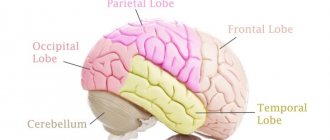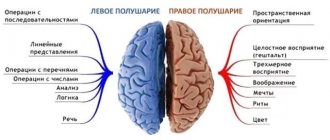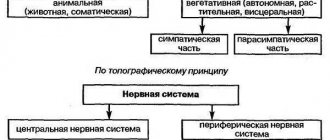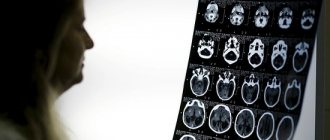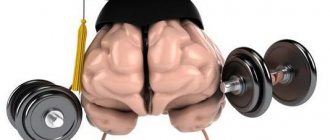The main regulator of the body's functioning is the brain. In this article we will briefly talk about the structure and functions of the parts of the human brain. Using this material, you can quickly and easily recall the topics covered in grade 8 and prepare additional information for the lesson.
The material was prepared jointly with a teacher of the highest category
Makshakova Natalya Alekseevna.
Experience as a biology teacher - 23 years.
Medulla oblongata and midbrain: structure and functions
The medulla oblongata and midbrain are collectively called the brainstem . They contain several vital centers:
- protective reflexes (coughing, sneezing);
- regulation of breathing;
- regulation of vascular tone;
- regulation of the respiratory system;
- orientation reflexes.
So, the medulla oblongata is a vital organ. Accordingly, if an injury to the medulla oblongata occurs, the person dies very quickly due to damage to the respiratory center.
This is interesting: human chromosomes, their number in a healthy person?
Cerebellum
The cerebellum is a specialized department that coordinates movements.
It receives a large amount of information from the balance organs, orders from the cerebral cortex and implements movement. The cortex communicates that you need to walk, and then the cerebellum controls your gait. The cortex is usually not involved in this process - you go automatically. In addition, the cerebellum regulates balance.
For example, when you haven't slept for a very long time and fall asleep while sitting, your head begins to tilt to one side - this means that the cortex stops telling the cerebellum to maintain balance.
This is interesting: the structure and functions of cell organelles.
The cerebellum also regulates muscle tone. In order to sit or simply hold your head up, you need some constantly tense muscles. The cerebellum does this too. And muscle memory: probably many people are familiar with the fact that some movement that you have not done before is difficult to do the first time. But then it becomes easier and easier, and over time it begins to happen automatically due to the fact that the cerebellum begins to do this.
Involuntary movements, that is, for example, withdrawing a hand from something hot, are made quick by the cerebellum due to the fact that it takes control of them.
Thanks to the cerebellum, you can do voluntary movements not quickly, but precisely, for example, take something specific from the table.
This is interesting: the main property of the plasma membrane is... what?
So, the cerebellum provides:
- speed of involuntary movements and accuracy of voluntary ones;
- coordination of movements;
- regulation of balance;
- regulation of muscle tone;
- muscle memory.
Thoughts and memory
The debate about what thoughts are, where memory is located and what the principle of intellectual activity is has been going on for at least the second century, but there are no answers to the question. Some refer to the lack of necessary equipment, which has not yet been created; most likely, others argue that people at the current stage of development are not able to understand much, while others argue that the answer must be looked for not only under the skull. The brain is a transceiver that receives information from the external environment, processes it, develops reactions of the body based on it, and also sends part of the data somewhere, to the external environment.
Until now, centers or areas in which all our experience is stored and responsible for memory have not been found. The idea that memory cells are located somewhere far away, and not in the head, is becoming increasingly interesting to the scientific community.
The answer to how this system works is hidden in the DNA molecule; it is the key to understanding many processes in the Universe, including in the brain. How to explain the communication of cells with each other if the capacity of nerve fibers for transmitting signals is clearly insufficient. Conclusion: the human brain works on completely different principles than scientists assume. And here it is necessary to take a closer look at the fundamentals of quantum mechanics.
Diencephalon
These are several departments:
- First, the pituitary gland and pineal gland, which are endocrine glands.
- Secondly, the hypothalamus, which controls the endocrine glands themselves.
- And thirdly, the thalamus, which we will talk about in more detail.
Thalamus means hillock. The hypothalamus is under the hillock. It is always located under the thalamus. The diencephalon is already a fairly high level of control, and here are the centers of various emotions and instincts: the pain center, the pleasure center, the centers of thirst, hunger and satiety, the center of sleep and wakefulness, the center of thermoregulation.
The thalamus is a set of structures that do very important things. Try now to realize how much information you receive from your senses every split second. You feel the temperature at every point of your body. You feel the touch of all clothing at every point with which it comes into contact, the heat and cold emanating from objects. You hear an insane amount of sounds. You smell a lot of smells. You understand where your arms, legs and head are in space. You see many objects. You know the distance to each of them, their color, their shape.
And all this happens all the time. This is a huge amount of information. If you received information in the form of raw data, you would go crazy with the need to process it. Therefore, 90% of all this information does not reach your consciousness. And a small part of it arrives in the form of already processed data. The thalamus does just that. It’s like a funnel: it takes a huge amount of information and filters out everything that’s irrelevant.
The thalamus processes all types of information except smell. The sense of smell immediately enters the cerebral hemispheres. It doesn’t just filter the rest of the information, but processes and summarizes it. For example, you see a person’s face, but you perceive it not as a set of individual features, but as a whole. But it will be difficult for you to describe the face of another person: you will have to imagine it and only then describe it. That's why the police use identikit photos: they don't ask you to tell what shape your ears are. They ask you to choose the best of different options. It's easier - you compare images. The thalamus is the most important organ that allows us to work with information much more efficiently.
Operation
It has been established that the hemispheres are responsible for the work of opposite parts of the body: the left, by and large, makes the right side of the body work, and the right - the left. They communicate with each other through the bridge - the corpus callosum.
The right hemisphere as a whole is responsible for object-figurative thinking, which is orders of magnitude faster than symbolic thinking (it is better to see once than to hear 7 times). People with a developed left hemisphere (left-handed people) find it easier to operate with images rather than numbers; it is difficult for them to understand drawings, diagrams and graphs. Activation and development of the left hemisphere makes left-handers creative people (inventors, writers, aces in various arts and activities), in a word - creators.
The left side is abstract logical activity. The work of the human brain with a more developed hemisphere makes its owner an intellectual, capable of lying, not seeing the integrity of things, processes and connections between them.
Forebrain
Specifically, the cerebral cortex is a large part of the volume of our brain, and it is divided into lobes.
Each of the lobes is paired, because we have two hemispheres, and each has one of these lobes: the frontal lobes, the seminal lobes, the temporal lobes and the occipital lobes. Here are the highest centers, which:
- process sensations;
- give orders for movements.
Let's look at which parts of the cortex receive signals from where.
- The occipital lobe deals with visual images. It receives signals from the eyes after they are processed by the thalamus, and a picture is formed here.
- The parietal lobe receives information about the sense of touch—that is, the sense of touch and pain.
- The temporal lobe receives information about sounds, tastes, smells, and the sense of balance. The brain itself does not feel pain - there are no nerve endings in it.
- The frontal lobe is actually the place where consciousness lives and a holistic picture of the world is formed.
If certain parts of the brain are damaged, certain body functions will also suffer. Thus, destruction of the occipital lobe will lead to loss of vision. The eyes will see something, but you will not be able to perceive the picture.
If one feeling is missing, then the others will be more developed. The part of the brain that was involved in vision begins to deal with something else - hearing or tactile sensations, and in a person who is blind from birth, the remaining senses will be much more developed than in the ordinary person.
But if an adult already loses vision, not part of the brain, but, for example, the eyes due to injury, you can put a mechanical implant there, roughly speaking, a camera whose outputs are connected to the nerves and the signal is decoded so that the nervous system can understand it. A person will be able to see because there is a part of the brain that analyzes vision. Only the organs of vision are missing. Eye implants already exist, they don't have very good resolution, but they work.
The brain of humans and other vertebrates is symmetrically divided into right and left parts. In this case, the left side mainly controls the right side of the body and vice versa. There is a common misconception that the left hemisphere is “logical” and the right hemisphere is “emotional.” This is just a popular myth. In fact, their functions are somewhat different, but this is not so fundamental.
Structure
The main organ of the nervous system consists of three parts:
TOP 4 articles that are read along with this
- 1. Spinal cord: structure and functions
- 2. Speech
- 3. Spinal cord: structure and functions
- 4. Memory
- two forebrain hemispheres;
- trunk;
- cerebellum.
It also has five departments:
- terminal or anterior, constituting 80% of the mass;
- intermediate;
- average;
- posterior, which includes the pons and cerebellum;
- oblong.
The white matter of the cerebral hemispheres of the forebrain is presented in the form of nerve fibers, which can be of three types:
- association – connect cortical areas in one hemisphere;
- commissural - connects the two hemispheres;
- projection – connect the cortex with the underlying formations.
Gray matter consists of neuron bodies; in the cerebral hemispheres, this substance forms the cortex and subcortical nuclei.
Rice. 2. Lobes of the cerebral cortex.
The following table will help you understand in more detail the structure and functions of various parts of the brain:
Cranial nerves
Like the spinal cord, nerves extend from the brain, and there are 12 pairs of them:
- olfactory nerve;
- optic nerve;
- oculomotor nerve;
- trochlear nerve;
- trigeminal nerve;
- abducens nerve;
- facial nerve;
- vestibulocochlear nerve;
- glossopharyngeal nerve;
- nervus vagus;
- accessory nerve;
- hypoglossal nerve.
Brain
Peripheral nervous system
A huge number of tiny nerves or neurons extend from the central nervous system. They connect to every organ, every muscle in the body, and form the peripheral nervous system.
The human body is intertwined with such a dense web of neurons that if you were to connect them into one thread, it would be 4 times longer than the distance from the Earth to the Moon.
Rice. 3. Neurons.
The peripheral nervous system transmits information received from the outside to the spinal cord and brain, and then back to organs, muscles or tissues. All information is received and transmitted in the form of impulses or signals. For example, when a person touches a hot surface, the skin sends an alarm signal to the brain about impending danger. It processes information in a split second and sends a response signal - to immediately pull back your hand. All this action happens incredibly quickly.
